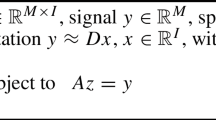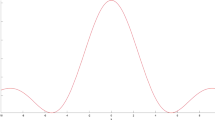Abstract
Let us assume that f is a continuous function defined on the unit ball of ℝd, of the form f(x)=g(Ax), where A is a k×d matrix and g is a function of k variables for k≪d. We are given a budget m∈ℕ of possible point evaluations f(x i ), i=1,…,m, of f, which we are allowed to query in order to construct a uniform approximating function. Under certain smoothness and variation assumptions on the function g, and an arbitrary choice of the matrix A, we present in this paper
-
1.
a sampling choice of the points {x i } drawn at random for each function approximation;
-
2.
algorithms (Algorithm 1 and Algorithm 2) for computing the approximating function, whose complexity is at most polynomial in the dimension d and in the number m of points.
Due to the arbitrariness of A, the sampling points will be chosen according to suitable random distributions, and our results hold with overwhelming probability. Our approach uses tools taken from the compressed sensing framework, recent Chernoff bounds for sums of positive semidefinite matrices, and classical stability bounds for invariant subspaces of singular value decompositions.


Similar content being viewed by others
References
R. Ahlswede, A. Winter, Strong converse for identification via quantum channels, IEEE Trans. Inf. Theory 48(3), 569–579 (2002).
E. Arias-Castro, Y.C. Eldar, Noise folding in compressed sensing, IEEE Signal Process. Lett. 18(8), 478–481 (2011).
R.G. Baraniuk, M. Davenport, R.A. DeVore, M. Wakin, A simple proof of the restricted isometry property for random matrices, Constr. Approx. 28(3), 253–263 (2008).
H. Bauschke, H. Borwein, On projection algorithms for solving convex feasibility problems, SIAM Rev. 38(3), 367–426 (1996).
E.J. Candès, Harmonic analysis of neural networks, Appl. Comput. Harmon. Anal. 6(2), 197–218 (1999).
E.J. Candès, Ridgelets: estimating with ridge functions, Ann. Stat. 31(5), 1561–1599 (2003).
E.J. Candès, D.L. Donoho, Ridgelets: a key to higher-dimensional intermittency? Philos. Trans. R. Soc., Math. Phys. Eng. Sci. 357(1760), 2495–2509 (1999).
E.J. Candès, J. Romberg, T. Tao, Stable signal recovery from incomplete and inaccurate measurements, Commun. Pure Appl. Math. 59(8), 1207–1223 (2006).
E.J. Candès, T. Tao, The Dantzig selector: statistical estimation when p is much larger than n, Ann. Stat. 35(6), 2313–2351 (2007).
A. Cohen, W. Dahmen, R.A. DeVore, Compressed sensing and best k-term approximation, J. Am. Math. Soc. 22(1), 211–231 (2009).
A. Cohen, I. Daubechies, R.A. DeVore, G. Kerkyacharian, D. Picard, Capturing ridge functions in high dimensions from point queries, Constr. Approx. 35(2), 225–243 (2012).
R. Courant, D. Hilbert, Methods of Mathematical Physics, II (Interscience, New York, 1962).
R.A. DeVore, G. Petrova, P. Wojtaszczyk, Instance optimality in probability with an ℓ 1-minimization decoder, Appl. Comput. Harmon. Anal. 27(3), 275–288 (2009).
D.L. Donoho, Compressed sensing, IEEE Trans. Inf. Theory 52(4), 1289–1306 (2006).
M. Fazel, Matrix rank minimization with applications, Ph.D. thesis, Stanford University, Palo Alto, CA, 2002.
M. Fornasier, Numerical methods for sparse recovery, in Theoretical Foundations and Numerical Methods for Sparse Recovery, ed. by M. Fornasier, Radon Series on Computational and Applied Mathematics (De Gruyter, Berlin, 2010).
M. Fornasier, H. Rauhut, Compressive sensing, in Handbook of Mathematical Methods in Imaging, vol. 1, ed. by O. Scherzer (Springer, Berlin, 2010), pp. 187–229.
S. Foucart, A note on ensuring sparse recovery via ℓ 1-minimization, Appl. Comput. Harmon. Anal. 29(1), 97–103 (2010).
G. Golub, C.F. van Loan, Matrix Computations, 3rd edn. (Johns Hopkins University Press, Baltimore, 1996).
F. John, Plane Waves and Spherical Means Applied to Partial Differential Equations (Interscience, New York, 1955).
M. Ledoux, The Concentration of Measure Phenomenon (American Mathematical Society, Providence, 2001).
B.F. Logan, L.A. Shepp, Optimal reconstruction of a function from its projections, Duke Math. J. 42(4), 645–659 (1975).
E. Novak, H. Woźniakowski, Tractability of Multivariate Problems, Volume I: Linear Information, EMS Tracts in Mathematics, vol. 6 (Eur. Math. Soc., Zürich, 2008).
E. Novak, H. Woźniakowski, Approximation of infinitely differentiable multivariate functions is intractable, J. Complex. 25, 398–404 (2009).
R.I. Oliveira, Sums of random Hermitian matrices and an inequality by Rudelson, Electron. Commun. Probab. 15, 203–212 (2010).
S. Oymak, K. Mohan, M. Fazel, B. Hassibi, A simplified approach to recovery conditions for low-rank matrices, in Proc. Intl. Symp. Information Theory (ISIT) (2011).
A. Pinkus, Approximation theory of the MLP model in neural networks, Acta Numer. 8, 143–195 (1999).
B. Recht, M. Fazel, P. Parillo, Guaranteed minimum rank solutions to linear matrix equations via nuclear norm minimization, SIAM Rev. 52(3), 471–501 (2010).
M. Rudelson, R. Vershynin, Sampling from large matrices: an approach through geometric functional analysis, J. ACM 54(4), 21 (2007) 19 pp.
W. Rudin, Function Theory in the Unit Ball of ℂn (Springer, New York, 1980).
K. Schnass, J. Vybíral, Compressed learning of high-dimensional sparse functions, in Proc. ICASSP11 (2011).
G.W. Stewart, Perturbation theory for the singular value decomposition, in SVD and Signal Processing, II, ed. by R.J. Vacarro (Amsterdam, Elsevier, 1991).
J.A. Tropp, User-friendly tail bounds for sums of random matrices, Found. Comput. Math. (2011). doi:10.1007/s10208-011-9099-z.
P.-A. Wedin, Perturbation bounds in connection with singular value decomposition, BIT 12, 99–111 (1972).
H. Weyl, Das asymptotische Verteilungsgesetz der Eigenwerte linearer partieller Differentialgleichungen (mit einer Anwendung auf die Theorie der Hohlraumstrahlung), Math. Ann. 71, 441–479 (1912).
P. Wojtaszczyk, ℓ 1 minimisation with noisy data, Preprint (2011).
Acknowledgements
Massimo Fornasier would like to thank Ronald A. DeVore for his kind and warm hospitality at Texas A&M University and for the very exciting daily joint discussions which later inspired part of this work. We acknowledge the financial support provided by the START-award “Sparse Approximation and Optimization in High Dimensions” of the Fonds zur Förderung der wissenschaftlichen Forschung (FWF, Austrian Science Foundation). We would also like to thank the anonymous referees for their very valuable comments and remarks.
Author information
Authors and Affiliations
Corresponding author
Additional information
Communicated by Emmanuel Candès.
Dedicated to Ronald A. DeVore on his 70th birthday.
Rights and permissions
About this article
Cite this article
Fornasier, M., Schnass, K. & Vybiral, J. Learning Functions of Few Arbitrary Linear Parameters in High Dimensions. Found Comput Math 12, 229–262 (2012). https://doi.org/10.1007/s10208-012-9115-y
Received:
Revised:
Accepted:
Published:
Issue Date:
DOI: https://doi.org/10.1007/s10208-012-9115-y
Keywords
- High-dimensional function approximation
- Compressed sensing
- Chernoff bounds for sums of positive semidefinite matrices
- Stability bounds for invariant subspaces of singular value decompositions




